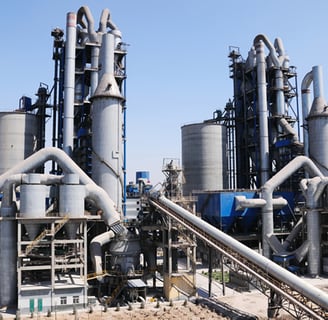cement
Cement is one of the most important building materials upon which modern infrastructure relies. This binding material bonds together various structural components, such as sand and gravel, to form solid, durable blocks used in all types of construction. Historically, cement has its roots in ancient times, when the ancient Egyptians used clay and primitive binders in the construction of pyramids, obelisks, and temples. Over the centuries, the cement industry has witnessed significant developments. Cement has transformed from a primitive mixture of calcium oxides and other minerals into a complex chemical compound known as Portland cement, developed in the 19th century. This type of cement, named after the Portland quarry in England, is now one of the most widely used types of cement in the world due to its excellent physical and chemical properties. Modern technological and scientific developments play a crucial role in improving the quality of cement and realizing its multiple uses in buildings and civil construction. Improving the composition of Portland cement and introducing new types, such as pozzolanic and American cement, has led to the production of materials that are resistant to harsh environmental factors such as salinity and humidity. Through these innovations, engineers and architects can design more durable and efficient structures, contributing to the realization of urban growth and development aspirations around the world. In addition to its essential role in building construction, cement contributes to the development of safer and more resilient infrastructure. Therefore, understanding the different types of cement and their uses is essential for anyone working in civil or architectural engineering. In this article, we will review the different types of cement and their diverse uses, focusing on Portland and American cement. Types of cement Cement is one of the most important building materials upon which modern infrastructure relies. This binding material bonds together various structural components, such as sand and gravel, to form solid, durable blocks used in all types of construction. Historically, cement has its roots in ancient times, when the ancient Egyptians used clay and primitive binding materials in the construction of pyramids, obelisks, and temples. Over the centuries, the cement industry has witnessed significant developments. Cement has transformed from a primitive mixture of calcium oxides and other minerals into a complex chemical compound known as Portland cement, developed in the 19th century. This type of cement, named after the Portland quarry in England, is now one of the most widely used types of cement in the world due to its excellent physical and chemical properties. Modern technological and scientific developments play a crucial role in improving the quality of cement and realizing its multiple uses in buildings and civil construction. Improving the composition of Portland cement and introducing new types, such as pozzolanic and American cement, has led to the production of materials that are resistant to harsh environmental factors such as salinity and humidity. Through these innovations, engineers and architects can design more durable and efficient structures, contributing to the realization of urban growth and development aspirations around the world. In addition to its essential role in building construction, cement contributes to the development of safer and more resilient infrastructure. Therefore, understanding the different types of cement and their uses is essential for anyone working in civil or architectural engineering. In this article, we will review the different types of cement and their diverse uses, focusing on Portland and American cement. Zain International for Mining & Export Contracting, Import and Export: For use in marine areas, agricultural lands, and industrial facilities exposed to harsh chemicals. This cement is characterized by high durability and excellent resistance to sulfate corrosion. These various types of Portland cement combine to meet various construction needs, each designed for specific purposes and boasting unique properties that help improve the quality of construction and ensure its sustainability over time. Uses of Portland Cement Portland cement is one of the most popular and widely used building materials in various construction projects. From foundations to concrete structures and finishes, Portland cement plays a vital role in enhancing the durability of infrastructure. In foundations, Portland cement is used for its high load-bearing capacity. It contributes to the stability of buildings and prevents them from being affected by pressure and cracking over time. It is also used in the construction of load-bearing walls and other structural elements that require a high capacity to resist both static and dynamic loads. For the construction of concrete structures, Portland cement is an excellent choice due to its combination with gravel, sand, and water to produce a strong and durable mixture. It can be used in the manufacture of columns, ceilings, and floors. This combination offers a high level of durability and sustainability for use in both residential and commercial buildings. In the finishing stage, Portland cement can provide a smooth and durable surface, making it a preferred choice for flooring and wall surfaces. This gives it flexibility, making it suitable for use in a variety of architectural and decorative applications. One of the most important benefits of Portland cement is its ability to withstand various weather conditions, such as heat, humidity, and freezing. This makes it ideal for use in a variety of environments and climates. It also protects infrastructure from corrosion and damage caused by various weather factors, extending the life of buildings and ensuring their sustainability. American cement, also known as American Portland cement or simply American-type cement, is a type of cement developed in the United States as a reliable alternative to traditional Portland cement. American cement is a calculating product produced using domestic raw materials, giving it the added advantage of reducing dependence on imported raw materials and empowering local industries. Chemical Composition and Technical Details American cement differs from traditional Portland cement in its chemical composition and manufacturing method. American cement consists of a carefully considered blend of chemicals, including silicates, aluminates, calcium, and other components, giving it unique properties. This formula is characterized by its ability to adapt to different climatic conditions and diverse environmental challenges, making it an excellent choice for various construction and industrial applications. Technically, American cement is manufactured using the latest technologies in materials science and chemical engineering. This involves precise grinding processes and controlled chemical reactions, resulting in a final product that meets global standards for quality and durability. The manufacturing process is complex and requires careful adjustment of various components to ensure balanced formulation and optimal performance. Choosing the right type of cement Properly selecting the right type of cement is one of the key factors in ensuring the success of any construction project, whether small or large. The process of selecting the right type of cement must be based on a set of basic criteria that ensure the best possible results and the achievement of the project's desired objectives. First, the nature of the project is a key factor in determining the appropriate type of cement. For example, if the project requires the construction of strong structures such as bridges or tall buildings, high-strength Portland cement is the ideal choice. Conversely, small and medium-sized projects such as fences or sidewalks can be satisfied with regular cement types that meet basic strength requirements. Second, environmental factors play a significant role in the selection process. In coastal areas or areas with high humidity, it is recommended to use salt- and moisture-resistant cements, such as sulfate-resistant cement, to ensure long-term protection of structures from corrosion and damage. In arid or desert regions, however, ordinary cement can be used without significant concerns about environmental conditions. Third, the available budget also determines the appropriate type of cement to use. Specialized types of cement may be more expensive, but they offer long-term benefits that reduce maintenance and repair costs in the long run. In cases where budgets are limited, you can look for types of cement that offer a balance between quality and cost. It's worth noting that consulting a professional construction engineer can help you make the right decision about the appropriate type of cement. Engineers have the experience and technical knowledge that enable them to provide recommendations based on practical experience and scientific principles, facilitating the construction process and ensuring optimal results.
Ihab gabr
4/19/2025


